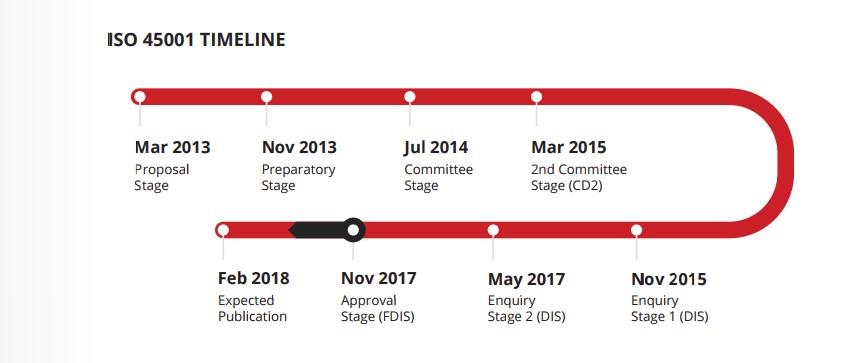Preparing For The Future Of Occupational, Health And Safety Management
With the emergence of globalization and its continual acceleration, the maintenance of physical and mental health of employees has gained momentum in the field of business management. That is why Occupational Health and Safety Management System has received increased attention and is considered the cornerstone of every organization’s long-term strategy. The OHSMS implementation promotes good working conditions, is seen as a prerequisite for survival in the current market, and provides a structured approach that ensures that the organization’s workforce is protected and compliant with the changing legislature.
ISO 45001 is the new standard developed by the International Organization of Standardization which will replace OHSAS 18001 and will become the baseline for Occupational Health and Safety Management. The standard provides a framework and guidelines for organizations to better control potential risks, and prevent work-related injuries, ill health and death. While the standard sets forth the specifications for systematic analysis, management of risk, management of regulatory compliance, and evaluation of the occupational health and safety performance, it is applicable to all organizations, regardless of size or industry.
Standing out with ISO 45001 implementation
The ISO 45001 standard was established with the same fundamental purposes as the other ISO standards and that is to ensure effectiveness, efficiency and continual improvement of a management system.
The ISO 45001 standard brings benefits to both, the organization and employees. Some of these benefits include:
- Reduction of the occupational health and safety risks
- Improvement of the OHS performance
- Support in integrating the OHS in the business processes
- Assurance of sustainable and socially responsible operations
- Recognition by regulators, public, and other interested parties
- Compliance with worldwide legislation
- Increased productivity and reduction of downtime
- Minimization of losses due to accidents and absence
- Reduction of costs due to insurance premiums

The real difference between ISO 45001 and OHSAS 18001
While both standards are focused on improving the well-being and the work-related conditions of the employees, there are several aspects in which these standards differ. While it tries to incorporate the health and safety aspects into the overall management system, the ISO 45001 standard takes a more proactive approach towards risk control. Thus, it enables the top management to embody the health and safety aspects of their decision-making processes. OHSAS 18001, on the other hand, takes a more reactive approach of risk control by delegating the health and safety responsibility to a health and safety manager rather than integrating it into the organization’s management system. Understanding the differences between these two standards is of the paramount importance as it enables the organization to explore the new organizational opportunities while experiencing a smoother transition into the new system.
Some of the main differences between these standards are:
Management Commitment
ISO 45001 places a significant importance on the management’s commitment as it regards it to be of utmost importance for the standard effectiveness and integration. Based on this standard, the safety culture of the organization depends on the involvement of the management and their support towards the employees. Instead of just providing oversight to the processes, the management needs to be a model for true safety leaders.
Worker Involvement
The new ISO 45001 standard engages employees in the big picture, and places on their shoulders the responsibility of being active participants in the implementation of the health and safety management system. Workers need to be provided with appropriate training and education in order to be able to identify risks and create a rewarding safety program. Moreover, with ISO 45001, the organization will be subject to regular audits, which will ensure that the organization is compliant with the standard’s requirements. These audits are openly conducted with workers as their input is valuable for reaching reliable audit results. Based on ISO 45001, the safety management within the organization is everyone’s responsibility.
Hazard vs Risk
As previously stated, ISO 45001 holds a more proactive approach towards risk, and as such it requires for hazards to be evaluated in advance and remedied before catastrophic outcomes occur. With ISO 45001 the organization will be able to discover hazardous risks before they cause any accidents or injuries. With audits conducted on regular basis, job safety analysis and monitoring of workplace conditions will be the vital bases that guarantee the proactive approach as specified by ISO 45001.
Structure:
Another important difference between ISO 45001 AND OHSAS 18001 is the structure. The new ISO 45001 standard is based on Annex SL which has replaced ISO Guide 83 and has applied a general structure, terminology, and definitions. This structure may seem very familiar for those that have had the opportunity to work with other standards such as ISO 9001 and ISO 14001. By using the same structure, the implementation of multiple management systems becomes easier as it streamlines the process. ISO 45001 can be best outlined as a proactive management system intended to place health and safety at the heart of your organization’s processes.

Transition from OHSAS 18001 to ISO 45001
Organizations that are currently certified against OHSAS 18001, have a three year period after the publication of ISO 45001 to adopt the new requirements into their management system before OHSAS 18001 is withdrawn completely. The organization’s certification auditors will complete a so-called ‘gap analysis’ audit to identify the key changes that the organization needs to implement to its existing processes in order to be compliant with the ISO 45001 standard. While there is a growing acceptance that the costs of compliance are less than the costs of failure, which costs are not just financial but also reputational, social and moral, the organizations should ensure that the Occupational Health and Safety Management System is integrated into their operational processes.
PECB is ready to support its customers on this transition by providing the most updated courses that give fundamental understanding of ISO 45001 and comprehensive knowledge of the implementation process and audit principles









